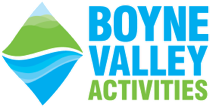This website uses cookies to help deliver its services. By using this website, you agree to the use of cookies as outlined in our Privacy Policy.


So you have decided you want kayak lessons but have no real idea how to go about it. You watch paddlers rolling/surfing/flipping their boats down at the river beside Boyne Valley Activities every weekend. You think this looks deadly. You want to give it a go, even if Swifts Wave looks like a 60-meter long purpose-built washing machine.
All you do know is you don’t really want to float down the Boyne at speed while strapped into a kayak upside down with your life flashing before your closed eyes. And we don’t want that either. Like all good things in life, there is a right way and a wrong way to to learn to kayak. So what is the right way, where do you learn, what do you learn and most importantly for any entry-level into a sport – will it be any craic!?!

The right way to learn how to kayak
In order for you to learn how to kayak, you must complete a Canoeing Ireland Level 2 kayaking Course. Canoeing Ireland is the governing body for all paddlesports in the Republic of Ireland. They are the Big Boss paddlers and they set the standards for the rest of us. All Kayak/Canoe Clubs and activity providers such as ourselves are affiliated with them. We deliver their training courses, as all the staff in Boyne Valley Activities were trained as instructors with them.
On successful completion of your course, you will get a Certificate of Proficiency. This states that you are capable of carrying out all the required tasks in a kayak. Then you are listed on the Canoeing Ireland database. That piece of paper you receive will allow you to paddle with any club you choose to join. They will be delighted to accept you as they know you will be able to handle yourself on the water.
The best place to take kayaking lessons
Luckily for you, this is a BVA Blog. You are in the right place for THE best training around. Our instructors pride themselves on delivering fantastic courses with a weekend of banter and craic along the way! As our name suggests, we do all our training courses on the Boyne in Trim. It is one of the best rivers to start on in the country as it has a gentle but steady flow. It has plenty for everyone once you know where to go. There are also enough obstacles and features for kayakers who want to progress further. Having this amenity on our doorstep means you can upskill straight away. This is a major factor you should consider when looking for Learn to kayak courses.

What do you learn on a Level 2 Kayak course?
First of all, you will paddle on flat water. Get your strokes right. Learn the trick to getting your boat going in the direction you want. You’ll build up confidence before you will progress to the moving water of Swifts Wave and other small rapids near our base on this stretch of the Boyne. Our two-day kayak course will rapidly enhance your skillset. You will learn loads more about watercraft and get to experience kayaking in river conditions. If you are like us and want to know absolutely everything that you will learn, check out the Canoeing Ireland syllabus which breaks the lessons down nicely.
Will it be any craic?
Kayaking is the best craic we have ever had. We are still friends with the people we took our first lessons with way back in the day when we first slipped a spraydeck on. We have made lots of new friends since. It seems like every weekend there are more people taking to the rivers of Ireland to play on the waves. Kayaking has given me great memories – from going over my first waterfall in Donegal to running the rollercoaster gorges in France and wild camping kayaking through the islands of Sweden. The wildest thing I ever did while kayaking has to be getting engaged, but that’s hardcore kayaking and not for beginners.

Kayaking is suitable for pretty much everyone. There are so many disciplines and options. Sign up to one of our training courses and see what all the fuss is about. Feel free to contact any of the Boyne Valley team to see what direction you might take. The first step – is talking to us.
See you on the water…



